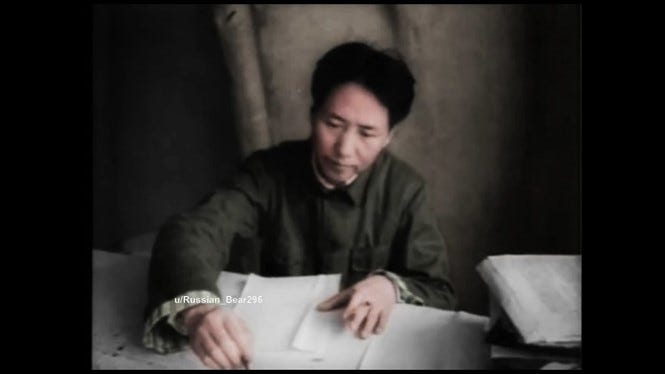Swimming
[a tsu, to the melody Water’s Music: the Prelude, Shui-tiao Ko-tou]
[translated by Nancy Lin]
I have just drunk the waters of Changsha
To come and taste now the Wuchang fish.
Swimming across the Grand Yangtse
With her thousand-mile surge,
I gain a full view of the broad Chu skies.
Let the wind blow and waves dash:
I sense Space today
As never in strolling any courtyard I can.
So said the Master by the river,
“How it flows ever on!”
Tortoise and Snake stand still;
Sails, wind-fed, shuttle in between.
Hence the birth of a Great Scheme:
A bridge shall fly across, north to south;
Nature’s chasm shall be man’s highway.
Walls of granite, too,
Shall rise on the west,
Turning back the Wushan Cloud-and-Rain
To conjure up placid lakes
On top of towering gorges.
Wouldn’t the Fairy Maid,
Fair as ever perhaps,
Be startled to find her world
So utterly changed!
Notes [by Nancy Lin]
Socialist reconstruction came to a new high in 1956. The construction of the Yangtse River Bridge at Wuhan had begun and the conservancy projects for the Yellow River and the Yangtse were under way. Mao arrived in the Wuhan area in June on a nation-wide tour of inspection and he wrote this poem after he swam across the Yangtse three times in four days – an event that led to the practice of yearly swimming meet throughout the nation since.
Waters of Changsha, according to the poet’s own notes, refers to the famed White-Sand Well east of the city of Changsha.
Wuchang fish: Sun Hao of the Wu Kingdom (in the third century) contemplated moving its capital from Chienyeh (Nanking) to Wuchang to the opposition of the bureaucrats, landlords and the rest of the wealthier strata, who put up the slogan: Rather drink Chienyeh water than eat Wuchang fish. “Changes in sentiment have taken place”, commented Mao humorously. “Wuchang fish is quite palatable in fact.”
Chu skies: Chu is the classical name for Hupei and Hunan.
The Master: namely Confucius whose well known remark is quoted here to convey the poet’s own sense of the infinity of time and space, of movement and change.
Tortoise and Snake: two hills at Hanyang and Wuchang respectively, which directly face each other from opposite banks of the Yangtse. On them now stand the bridge heads of the Yangtse Bridge at Wuhan, completed in October 1957.
Nature’s Chasm: The Yangtse River has been so called in Chinese history, acting as it often did as a great divide between north and south China.
Walls of granite and placid lakes refer to the projects of the Big Dams over the Three Gorges on the Hupei-Szechuan border.
Wushan Cloud-and-Rain: Sung Yu’s ‘Ode of Kaotang’ (third century B.C.) tells of the Fairy Maid of Wushan Hill who assumes the form of a fleeting cloud in the morning and of swift rain in the evening; the phrase is used here to mean the torrents of the upper Yangtse.
The Fairy Maid is known in legends as the daughter of Red God, who died a valiant aid to the Great Yu in regulating the Big Flood and was buried on the southern slope of Wushan, where on top of Peak Feifeng (Flying Wind) a temple has been built in her honor. Once again the concluding line ushers forth the poet’s favorite theme of change, theme of the triumph of man over nature.
[next - 24. Reply to Li Shu-yi]



